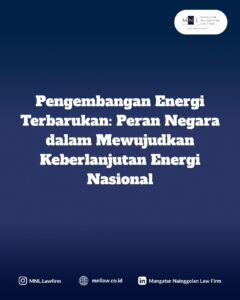
In Indonesia, the definition of Renewable Energy (“RE”) is stipulated in Article 1 point 7 of Law No. 30 of 2007 on Energy (“Law 30/2007”), which states: “renewable energy is energy derived from renewable energy sources.”
Furthermore, renewable energy sources are defined in Article 1 point 6 of Law 30/2007 as:
“energy sources derived from sustainable energy resources if managed properly, including geothermal, wind, bioenergy, sunlight, flow and waterfall, as well as oceanic motion and temperature gradient.”
Law 30/2007 specifically regulates and defines renewable energy as a type of energy that is not yet commonly used or is still under development, and RE as energy derived from energy resources that can be naturally replenished quickly. This law serves as the primary legal basis governing the National Energy Policy (“KEN”) in Indonesia, explicitly mandating the increased utilization of RE, affirming state control over it for the welfare of the people, and providing support in the form of incentives and the setting of purchase prices for renewable electricity.
In addition to Law 30/2007, the government issued Presidential Regulation No. 112 of 2022 on the Acceleration of Renewable Energy Development for Electricity Supply (“PR 112/2022”), which specifically regulates the acceleration of the development of power plants based on renewable energy sources.
Implementation of RE Management
Further, in the context of technical implementation, Article 4 paragraph (1) of PR 112/2022 states:
“Renewable Energy Sources are energy sources derived from sustainable energy resources if managed properly, including geothermal, wind, bioenergy, sunlight, flow and waterfall, as well as oceanic motion and temperature gradient.”
Article 4 paragraph (2) of PR 112/2022 further stipulates:
“The purchase of electricity by PT PLN (Persero) shall be made from power plants that utilize Renewable Energy Sources, which consist of:
- Geothermal Power Plants (PLTP);
- Hydro Power Plants (PLTA);
- Solar Photovoltaic Power Plants (PLTS);
- Wind Power Plants (PLTB);
- Biomass Power Plants (PLTBm);
- Biogas Power Plants (PLTBg);
- Ocean Energy Power Plants; and
- Biofuel Power Plants (PLT BBN).”
This list demonstrates the broad scope of renewable energy-based power plants recognized and accommodated in national policy, reflecting the state’s commitment to diversifying energy sources toward a cleaner and more sustainable energy system.
One current implementation of RE being developed in Indonesia is through the carbon trading mechanism on the Carbon Exchange (IDXCarbon), established in 2023 based on the Financial Services Authority Regulation No. 14 of 2023 on Carbon Trading Through the Carbon Exchange. Companies that successfully reduce carbon emissions in their business processes are granted certificates indicating the amount of emissions reduced. These certificates can then be traded on IDXCarbon. This emphasizes that the implementation of RE through carbon trading represents both government and business sector roles in supporting the national energy transition.
Parties Responsible for RE Development
The primary responsibility for implementing Law 30/2007 and PR 112/2022, as well as for the overall development of RE, lies with the government. The Ministry of Energy and Mineral Resources (MEMR), particularly through the Directorate General of New, Renewable Energy, and Energy Conservation (DGNREEC), serves as the main coordinator tasked with formulating policies, issuing derivative regulations, and overseeing the implementation of RE projects. The National Energy Council (NEC) plays a strategic role in formulating the KEN and supervising its implementation.
Additionally, the Ministry of Finance plays a role in providing financing, the Ministry of Environment and Forestry ensures environmental sustainability, and Regional Governments are responsible for identifying potential and facilitating RE development in their regions through the Regional General Energy Plan (“RUED”).
Conclusion
The development of RE in Indonesia has a strong and comprehensive legal foundation, as regulated under Law 30/2007 and reinforced by PR 112/2022. Based on these regulations, the state holds the primary responsibility to encourage the optimal utilization of renewable energy sources in order to achieve national energy independence and security.
One tangible form of RE implementation is the carbon trading mechanism, where companies that succeed in reducing emissions can obtain emission certificates that are tradable on IDXCarbon. Thus, the government’s obligation to develop RE is not merely an act of law enforcement but also a concrete step toward a sustainable, efficient, and environmentally friendly energy transition for the present and future generations.
